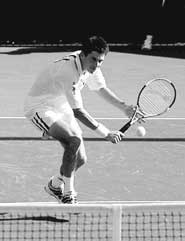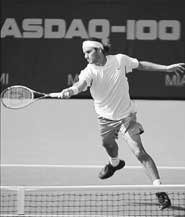<% ns_puts [mkm_getnavbar] %>

Optimizing Your Technique: Part 3
By Nick Saviano
|
|
 |
|
Note the quick turn of the shoulders and compact backswing as Agassi prepares to hit a backhand return and Hingis hits a forehand return. |
|
In this final excerpt from "Maximum Tennis," Nick Saviano continues his analysis of the true fundamentals of the return, the volley, and the serve (see part 1 and part 2 in the Lesson Library.
Return of Serve
The return is a hugely important shot
in anyone’s game, yet it is one of the least practiced shots. Remember,
every point includes a return of serve (unless there is a double fault or
ace), which makes it the second most important shot in the game.
Improving your return technique will pay big dividends. Here are a few of
the keys to hitting returns well. These points are applicable to both
forehand and backhand returns.
-
Split step. Start your split step right before your opponent strikes the ball. Focus on when contact is made to track the ball.
-
Front shoulder. Think in terms of a quick turn of your front shoulder to rotate your upper body. Technically, other things will be happening, but you don’t need to worry about them. A quick loading of the upper body will enable you to take a short backswing yet still generate power on your return.
-
Compact backswing. Often this will happen naturally if you get a quick turn of your front shoulder. The harder the serve, the smaller the backswing.
-
Footwork. Your objective is to hit the ball in your optimum hitting zone by moving your feet. Try to keep your feet underneath you, as opposed to stretching for the ball. If you attempt to use your feet to get to the ball without reaching, you will move your feet more quickly and stay on balance. If the ball is far away or coming quickly, you will automatically stretch out to reach for it. The idea is that you don’t want to reach for the ball unless absolutely necessary.
-
Swing. If you take the serve early, you should feel like you are swinging through the flight of the ball, as opposed to swinging up (even though you will technically be swinging from low to high). There is less upward action on your swing because the ball is bouncing upward quickly from the ground.
|
To order Nick Saviano’s book Maximum Tennis: 10 Keys to Unleashing Your On-Court Potential click here. |
|
|
I was at the practice courts at the All England Club during the first week of the 2001 Wimbledon championships, when Andre Agassi came up and sat right by me as he was waiting for his practice court.
We started chatting, and I took the opportunity to show him an article on return of serve that I had written in the USTA High Performance Coaching Newsletter which goes out to 25,000 coaches. The article featured a set of sequence pictures of Andre hitting a backhand return.
After studying the pictures, his response stood out in my mind. He said, “Nick, I don’t even think about taking the racquet back. All I think about is keeping the racquet in close to my body and turning my shoulders . . . the technique has got to be simple!”
Considering that he has one of the greatest returns of all time, I thought I would share that bit of advice with you.
Volleys
The secret to great technique on the volley is simplicity. Most important is the ability to move to the ball, on balance, with a minimal backswing and the ability to control the racquet face at impact. The more moving parts and the bigger the swing on the volley, the harder it is to master the stroke. Unlike on ground strokes, there is not as much variation in technique on the volley among the top professionals.
   Tim Henman prepares to hit a backhand volley. |
- Prepare your racquet first and then move. When you are setting up for the
volley, think in terms of preparing your racquet first and then moving to
the ball. In fact, you will be moving and preparing the racquet at the same
time. However, lining up your racquet early gives a clear gauge as to
exactly where you need to move to get in the best position for the shot.
Too many players see the ball, start to move toward it, and then try to prepare their racquet. The result is poor body position in relation to the ball and trouble preparing the racquet in time.
- Maintain good posture. Throughout the preparation and hitting phases,
keep your shoulders and back relatively straight.
- Keep your elbow bent. As you prepare your racquet for the volley, make
sure your elbow is bent. You should never have a straight arm in the
preparation phase of the volley.
- Hold the racquet head above your wrist. As you prepare for the volley,
your racquet head generally will start well above your wrist, with the
racquet face slightly open.
- Turn your upper body on the backhand. Do not start a backhand volley with your whole body turned sideways. Facing the ball, rotate your upper body as you prepare, getting a pull in the shoulders for the strength you need on the shot, then step. This will help load the large-muscle groups of your upper body.
   Roger Federer executes a forehand volley. Federer displays beautiful, simple technique. |
- Keep your elbow out on the forehand. Keep your elbow bent and slightly
out in front of your body as you prepare for a forehand volley.
- Use a compact swing. Yes, the pros often take a big swing at the ball,
but every great volleyer can execute either the forehand or the backhand
with minimal backswing and follow-through.
- Control the racquet face before and after the hit. If you can control the racquet face before and slightly after the hit (if you control it before and after the hit, it means you have maintained control on contact), then you have a great chance of consistently hitting the volley well.
With this in mind, in the preparation phase, attempt to line up the
racquet
face directly behind the flight of the oncoming ball. In reality, you
might be slightly higher than the oncoming ball, depending on the shot,
but the key is to line it up quickly and not turn the racquet face away
from the oncoming ball. Then focus on keeping the face of your racquet
facing the direction of your target after you make contact, and hold this
for a split second.
This will help to keep your racquet face pointed in the right direction
throughout the hitting zone. It will also help minimize the size of your
backswing and follow-through. All great volleyers can do this at will. So,
don’t be confused when you see some of the pros taking a big swing or
flipping their racquet head around on the follow-through.
|
|
Many years ago (I must have been 14) at the Berkley Tennis Club, they held a big professional men’s event. My idol Rod Laver, two-time Grand Slam winner, was competing in the event. So, I went to the tournament three days in a row to watch him play. I wanted to find some time when I could ask him about his technique on the volley, but it was impossible to get near him when he was at the courts.
However, I noticed that he would actually walk to the courts from his hotel, which was close to the tennis club. So on Friday, before his quarterfinal match, I got to the club early and waited outside so that I could “intercept” him on the street as he was walking to the courts. As he approached, I got really nervous. But I managed to spit it out. “Mr. Laver, can I ask you a quick question?” “Go head if you keep walking,” he said. “I am trying to improve my volleys. Is there anything you can tell me that might help?”
He held his racquet up as if he were going to hit a forehand volley and said, “Keep the racquet work simple, and be aggressive with your feet. That is when I volley my best.” At first I didn’t fully understand, but I never forgot what he said. As I practiced my volley and improved it over the years, it became more and more clear how right he was. To this day, the concept of simple racquet technique with good movement to the ball is part of my technical philosophy on the volley.
About 25 years later, I had the privilege of riding with Rod in the courtesy car at the U.S. Open. I mentioned the story to him. He remembered the tournament but not the young boy asking him about the volley. The important thing is I didn’t forget!
|
|
Serve
The serve is the most important shot in the game. Every point starts with it, and it is the only shot in tennis in which you have total control over how you execute it. To say you should practice first and second serves is an understatement!
I could write an entire chapter on technique for the serve. Short of doing that, I have selected a few of the most important points on technique. Once again, if you improve any one of the following items, you will help your serve significantly.
- Relax. The serve is liquid power. In particular, make sure there is
little tension in your face or racquet arm.
- Balance. Be balanced at the start.
- Front toe. Start with your front foot turned to the side (at least a 30
percent angle from the net), or it should turn as you rotate your
shoulders. If your toe points directly toward the net, your ability to
turn your hips and shoulders will be limited.

<% ns_puts [nsv_get mkm_includes mkm_oldContentFooter_inc] %>




